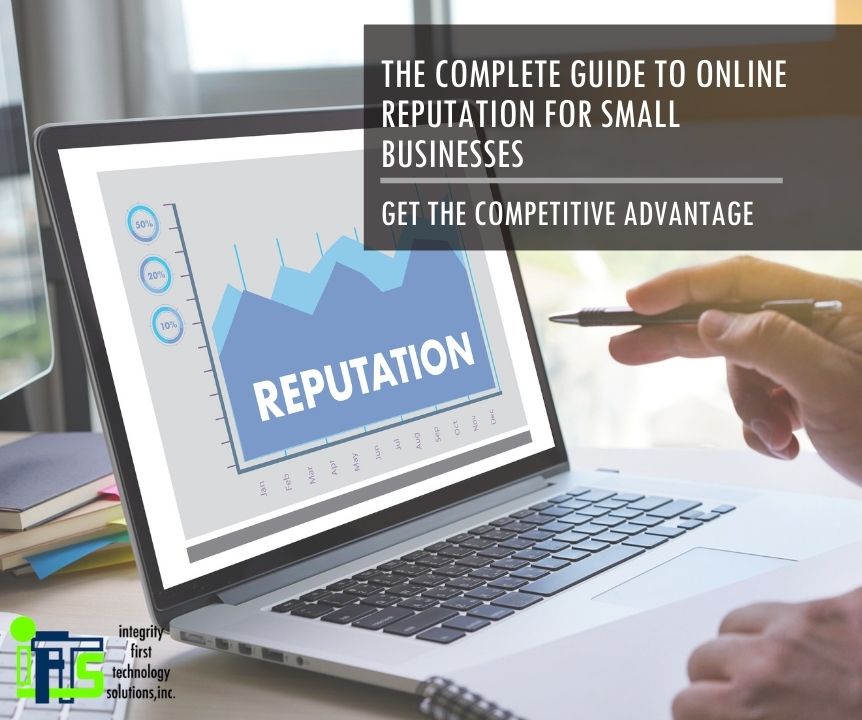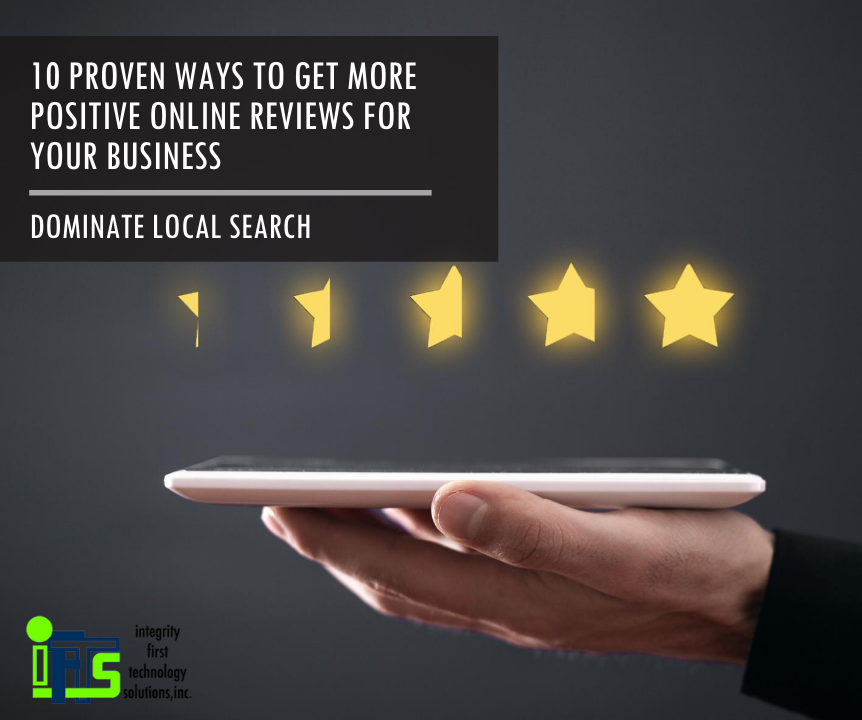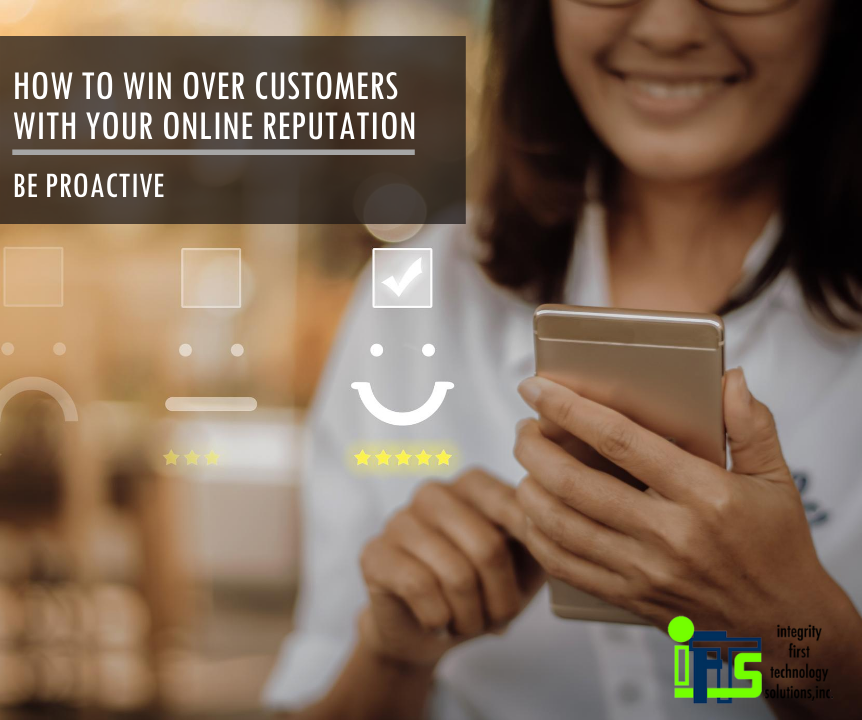
The sales cycle for most businesses today has more steps because customers are smart and informed. The more that you can present your company in a positive light to your target market, the more likely they are to buy from you…and not your competition.
This is where your online reputation factors into the equation.
Growing the online reputation of your business positively consists of two main tasks:
- Reputation Management
- Reputation Marketing
Reputation Management is the process of soliciting, collecting and supervising online reviews for your business. This will both build and protect your reputation, ensuring the people that Google you find positive, persuasive content. It also will help you improve customer experience with the feedback that you receive.
Reputation Marketing highlights and boosts positive online content that customers provide (like reviews). This may be done through both traditional and digital channels. Leveraging positive reviews/ratings increases the visibility of a company.
These two tasks must be done on a regular basis to be competitive and help ensure the future growth of the company.
Why Should Online Reputation Matter to You?
Don’t underestimate the importance of your online reputation!
Small businesses, especially ones that have a local target market, should have a plan in place to grow their reputation positively. In fact, 82% of local searches are followed with an in-person visit to the store. Local searchers are definitely using the internet to check out where they want to spend their money before they leave the house. Any business that lacks an enticing online presence is risking losing business to well-positioned competitors…even if that competitor has a worse product or service.
Even when you have the best product with the best customer service at unbeatable prices, if you have negative social signals or if your online reputation isn’t great, prospects will be hesitant to give you their time or money. Consumers are now searching for the best service at the best price. They are using Google, Facebook, Yelp, Instagram and more to find it. Social media, search results and online content are allowing buyers to make very informed spending decisions.
“82% of consumers read reviews for local businesses, including 93% of people aged 35-54” (BrightLocal)
When your ideal prospect searches for the type of product or service in your location that you provide, you need to ask yourself two questions:
- Does your business show in the search results?
- Are you the obvious choice with 5-star reviews and a professional, authoritative online presence?
If the answer to either of the above questions is “No”, then chances are you just lost a customer.
Customers Trust Online Reviews to Guide Their Decisions, But Don’t Just Take Our Word For It…
“Consumers read an average of 10 online reviews before feeling able to trust a local business.” (BrightLocal, Local Consumer Review Survey)
“Businesses ranking in Google’s local positions 1-3 have an average of 47 reviews, while businesses in positions 7-10 have 38 reviews.” (BrightLocal, Google Reviews Study)
“Having a 5-star rating earns a business 39% more clicks from Google local results than having a 1-star rating.” (BrightLocal, Impact of Reviews and Ratings on Click-Through Rates)
Want more clients? Using the facts above, a well-positioned online reputation can help you grow your business more efficiently than practically any other form of marketing.
What are the Benefits of Online Reputation Management for My Small Business?
Crafting a positive online presence has a multitude of benefits for a small business. It will establish credibility and authority, which gives your company a competitive advantage over others in your market. Be the obvious choice for your prospects!
Want a salesman that works 24/7/365, advertising you as the best in your locale? This is what a positive online reputation can do for you. According to BrightLocal, “Review ratings are the biggest driver of clicks in local search engine results”.
Additionally, a great reputation can help with your search engine optimization (SEO). Online reviews, directories, business profiles and more help your website rank higher. Thus, exposing you to a new and wider audience.
You now may be asking yourself, “This is great, but how do I start?”
That is what the rest of this guide will cover.
What Should A Small Business Do To Grow Their Online Reputation?
Step 1: Claim, Manage and Optimize Your Business Listings and Online Review Site Accounts
Review sites are vitally important when maintaining your reputation. This is where consumers go to research companies and products. One goal for your business should be showing up in Google local results with good reviews.
Sometimes, people are willing to take their research to the next level. This is where review sites come in. For example, did you know that Yelp has over 178 million site visitors monthly? They are all looking to confirm that they will get what they want from a particular business.
Make review sites work for you. Build and protect your online reputation by building your review set on multiple sites. Make sure to respond to every review in a way that is consistent and persuasive to potential customers reading.
Claim your business profiles on all review sites that are pertinent to your business. Don’t forget any local directories as well! Complete the profiles and be sure to use keywords and phrases that your target audience may be interested in. Make sure that your NAP (Name, Address, Phone Number) are consistent across all profiles. For example, don’t use “Road” in one and “Rd” in another. Pick one usage and apply it across all online properties. Be sure that your website has the same exact information, as well.
Missing, incomplete or duplicate information in these listings can hurt your business and your SEO!
Some of the top review sites that you may want to consider are:
- Google My Business
- Yelp
- Better Business Bureau
- Trip Advisor
- Foursquare
- Angie’s List
Step 2: Create and Optimize Your Social Media Profiles
When you are first starting this plan, Googling your business normally results in various social media profiles for the owner and the business being returned. This is exactly why you should claim and establish your social media profiles.
Social media profiles generally rank highly for personal names and business names. If you have not done much to establish yourself, this is a great way to control what prospects can see about you. You have complete power over what your profiles say and the imagery displayed.
It’s important to claim these profiles as soon as a business is established. Profile names are first-come, first-serve, so it is possible that someone else could claim your name. Don’t let your competition block you, or even worse, create a fake profile and pretend to be you.
An active social media presence lets you promote your brand and establish your voice. Your content will help create relationships with your clients. It also lets you showcase your thoughts, opinions, interesting articles, reviews and more.
When claiming your profile, be sure to fill everything out in its entirety. Include your NAP from above, your website, contact information, logo and lots of photos. People like to see the people behind the business.
Step 3: Solicit and Manage Reviews
Create a process for your business to request online reviews from your customers and make sure that you and your employees follow it every time.
“76% of consumers that are asked to leave a review go to write one.” (BrightLocal, Local Consumer Review Survey)
Monitor your review profiles for new reviews and be sure to respond to all new feedback.
When you receive a positive review, it is easy to write a response. Thank them for their time and review, use their name, talk about your commitment, let them know that their feedback is important and invite them to take another step with your company.
Receive a negative review? You need to reply!
“45% of consumers say they are more likely to visit a business that responds to their negative reviews.” (ReviewTrackers, Online Reviews Survey)
Reply to the reviewer using a courteous tone, and apologize for the experience that they had. Then, offer to discuss the issue offline. This way, potential clients will see that you care about customer satisfaction and that you tried to make it right – allowing you to flip a negative into a positive.
Step 4: Create a Blog with Consistently-Published, Quality Content
Your online reputation also comes from the authority that you have established. A blog is a great way to accomplish this. Blog entries published regularly with proper SEO ensures that the content and images that you create occupies the top search results for your name and business.
Worried about how to start your blog?
Here is our blog quick-start guide:
- Set up your blog in WordPress (You can follow this guide if you run into trouble https://www.wpbeginner.com/start-a-wordpress-blog/).
- Install the free Yoast SEO plugin (https://wordpress.org/plugins/wordpress-seo/).
- Identify 13 commonly asked questions that you hear from your customers frequently.
- Answer the questions. If writing is not your thing, record yourself answering the questions on your phone and use https://otter.ai/ (free tool) to transcribe it.
- Create one blog entry per question.
- SEO each entry with page titles, meta descriptions, tags, URLs, image names etc.
- Use WordPress’ built in functionality to schedule one of these entries to post every 2 weeks. This gives you a regularly scheduled post for the next half-year.
- BONUS: Film yourself reading the blog entry and post the video to YouTube with a link back to the blog. This will help with authority and SEO.
Step 5: Get Started
You now have everything that you need to begin. Don’t jeopardize the time, money (and maybe tears) that you have put into your business by neglecting to build and maintain a positive online presence!
Need help getting started or want someone to take over the responsibilities of this task? Contact IFTS and ask about our ReviewLead free trial. We make online reputation a stress-free experience for you.


